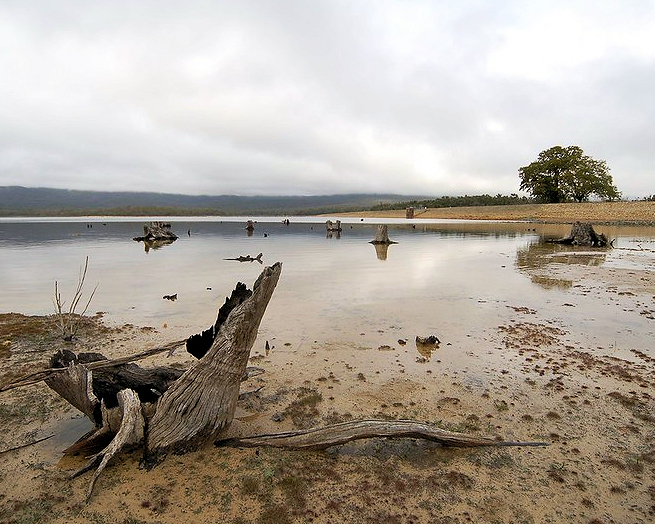 We, the Napa Group of the Redwood Chapter of the Sierra Club have been following the process of the GSPAC and attempted to contribute to the discussion. We feel that the plan as drafted follows the state guidelines, but misses the opportunity to establish a sustainable framework for Napa Valley’s water. (Photo credit: Berit Barton)
We, the Napa Group of the Redwood Chapter of the Sierra Club have been following the process of the GSPAC and attempted to contribute to the discussion. We feel that the plan as drafted follows the state guidelines, but misses the opportunity to establish a sustainable framework for Napa Valley’s water. (Photo credit: Berit Barton)
The sub-basin is not the valley; it’s a lagging indicator of water sustainability.
Napa Valley is a classic long narrow valley. It is comprised of a watershed that is bounded on three sides by tall hills that guide surface and groundwater migration toward the long narrow center of the valley, where the sub-basin and the Napa River interactively migrate the water toward San Pablo Bay. The area designated as the sub-basin is a very small area relative to the watershed. It is a small area relative to the area used for groundwater. It is a very small contributor to domestic water supply.
A GSP that deals solely with the sub-basin is not protecting the groundwater in the sub-basin because it inadequately monitors the flows that supply the sub-basin or the use, and increasing use, of water that would normally flow into the valley floor and sub-basin. It does not adequately represent the needs of all communities, as there are obvious scenarios in which all communities will become directly dependent on sub-basin water supplies.
It is the responsibility of the GSPAC to fully appreciate the unique attributes of the system of which the sub-basin is a component. It is the responsibility of the GSPAC to understand and document the communities involved in the system and the interdependencies involved. It is not the responsibility of the GSPAC to draw the boundaries of discussion, management, and planning so tightly that most of the affected communities are left by the sidelines while the primary focus becomes compliance with the smallest area of concern. This draft plan has missed the most significant opportunity given to it - establishing sustainability measures and management in the era of climate change and uncertainty carried with it.
The GSP recognizes the inadequacy of the climate scenarios required by the state. From Draft Section 8.9, page 8-36: The HadGEM2-ES-RCP85 model does not project extreme drought conditions in the Napa Valley which could influence future planning and mitigation. This finding is significant. The authors of the GSP recognize that the climate scenarios required by the state are inadequate yet spend significant resource drafting a plan based on those weak scenarios. They could develop a set of scenarios that anticipate prolonged drought, rainfall patterns that result in less percolation, and other patterns that are increasingly likely in the era of climate change. They did not do this. They built a plan on a knowingly weak foundation. This is negligence.
 We offer one simple and likely scenario: a sustained mega drought. The City of Napa currently obtains about half of its water from the State Water Project, augmented by two reservoirs. In this scenario, the State Water Project allocation is likely to go to 0, and the city will consume its reservoir reserves. Where does the city go next? Groundwater. The significant number of households and small holdings that get water from wells outside of the sub-basin will see their wells go dry. They will request Napa City and County for trucked-in water, as will many agricultural businesses that were not designed to dry farm. There will be much more demand on sub-basin groundwater. A sudden run on sub-basin groundwater is inevitable, and the resource that appears to be stable will experience a sudden demand from all communities. This, while the amount currently drawn from the sub-basin is essentially unknown, as there are no meters on wells, even the large corporate winery wells. We will quickly be in water wars, with everyone demanding a fair share of a resource without known capacity. We might see the adverse conditions listed in the GSP suddenly appear, with no viable action plan to forestall continued degradation of the shared resource. (Photo credit: Janet Guynn)
We offer one simple and likely scenario: a sustained mega drought. The City of Napa currently obtains about half of its water from the State Water Project, augmented by two reservoirs. In this scenario, the State Water Project allocation is likely to go to 0, and the city will consume its reservoir reserves. Where does the city go next? Groundwater. The significant number of households and small holdings that get water from wells outside of the sub-basin will see their wells go dry. They will request Napa City and County for trucked-in water, as will many agricultural businesses that were not designed to dry farm. There will be much more demand on sub-basin groundwater. A sudden run on sub-basin groundwater is inevitable, and the resource that appears to be stable will experience a sudden demand from all communities. This, while the amount currently drawn from the sub-basin is essentially unknown, as there are no meters on wells, even the large corporate winery wells. We will quickly be in water wars, with everyone demanding a fair share of a resource without known capacity. We might see the adverse conditions listed in the GSP suddenly appear, with no viable action plan to forestall continued degradation of the shared resource. (Photo credit: Janet Guynn)
Cascading failure scenarios do not arrive gently on tiptoe; they arrive as a surprise that comes in all windows and doors. As in most failure cascade scenarios, it is a surprise – an inevitable surprise.
The opportunity presented to the GSPAC was to frame the challenge according to the unique attributes of Napa Valley and to develop a sustainability plan with that full consideration.
Process failures
What enabled the giant missed opportunity was a series of process failures, including
Missing communities
Disadvantaged and minority communities were simply not represented in this process in any way. Though there was clear statement that such participation was important, it was simply overlooked in practice. There was no such representation on the GSPAC. There was no outreach. There was a proposal for involving disadvantaged communities in input from one committee member, it was ignored.
Suppression of discussion
The GSPAC meetings were essentially devoid of discussion. They were stuffed with presentations and reports. Whenever there was the chance that a significant discussion might break out, it was ruled out of order or out of scope.
The members who were interested in framing discussions to include factors and communities outside of the sub-basin, the discussions were quickly suppressed. In fact, one member could only get a point made by writing a letter to the committee on which he sits.
Methodology failures
Representative Wells
The draft plan refers to representative wells in the sub-basin. The term “representative” is a statistical notion in which those sampled are representative of the whole. There is enough known about the population that a sample can have the same properties as the whole. An analyst can select a representative or a random sample, with evidence that it is a proper proxy for gathering data from every well. No such evidence was provided. Rather, the wells selected were the ones available and convenient. Characterizations of the sub-basin are not rigorous, as analyses and inferences are based on data which have the common property of being convenient.
The draft GSP has impressive hydrogeologic information, but alas lacks a key data set: What is the level of each well, and how much is taken from each well site. Yes, dedicated sampling wells offer different kinds of information than production wells, but the combination will give better sampling opportunities, a more representative sample, and knowledge about usage and effects of one well on others.
We have the opportunity to collect data from every well in the sub-basin and in the watershed to better characterize the complexity of the sub-basin and the interactions among different wells and pumping volume. We should develop models based on rigorously collected data, rather than conveniently collected data.
The GSA should prioritize Supplemental Actions 11.7.1, “Active Production Well Inventory”, and 11.7.5, “Adopt Well Metering and Reporting Standards” so that the necessary data can be acquired.
Modeling: insensitive to uncertainty
The modeling platform used is very technically sophisticated and complex. It processes large volumes of data and many layers of computation. To avoid computational overload, there is a simplification that is done. Values that are variable or uncertain are replaced with constants. This simplification, which appears to be a common practice, renders the model less sensitive to uncertainty or interactions between variables. The modeling exercise is more likely to result in a sense of familiar security, perhaps a false sense of security.
Heading into a world that has increasing uncertainty, including variability patterns not previously experienced, the County, the GSPAC, and the state should be challenging the modelers to better understand the impact of the determinative modeling tools being used, and ways to mitigate the kinds of errors that such methods produce.
A very simple explanation of the problem was published here:
Summary
We see the sub-basin as one part of a system that supports the water needs of many communities, including the flora and fauna of the valley. We see the framing of the GSP as being sub-basin only, rather than as a system under pressure from development, growth, and climate change.
We see the process of creating the GSP as being overly constrained such that compliance is achieved at the expense of the welfare of the communities of Napa Valley. This process has been managed to minimize participation, collection of classes of critical data, and full appreciation of the uncertainty that climate change is bringing.
The GSP recognizes that the “the variability of future climate scenarios will be a presiding factor in formulating groundwater management actions and projects for the Subbasin.” (Section 8.10)
We recommend that this current draft of the GSP not be accepted.
Signed by the Executive Committee of the Napa Sierra Club Group